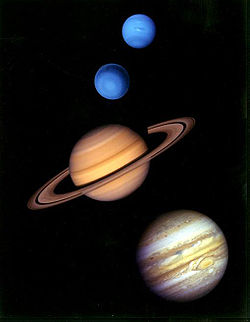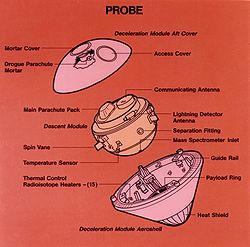- Outer planets
-
The outer planets are those planets in the Solar System beyond the asteroid belt, which typically refers to these gas giant planets in order of their distance from the Sun:
- Jupiter is the largest planet in the Solar System, with distinct bands and four very large satellites.
- Saturn is the second largest planet, with a large and bright ring system.
- Uranus was discovered in 1781. It is tilted almost onto the plane of its orbit.
- Neptune was discovered in 1846 as a result of its perturbations of Uranus.
The gas giant outer planets all have ring systems, although all but Saturn's are faint.
Another aspect common to the gas giants is their many natural satellites, two of which are larger than the planet Mercury (Jupiter's Ganymede and Saturn's Titan). That pair and Io, Callisto, Europa, and Triton, are larger than either Pluto or Eris.
This region of space is also occupied by centaurs, various fields of trojans, and many comets.
Pluto had been considered as an outer planet from its discovery in 1930 until its reclassification as a dwarf planet in 2006 (see also Kuiper belt).
Contents
Exploration
In situ exploration by spacecraft includes Pioneer 10, Pioneer 11, Voyager 1, Voyager 2, Ulysses, Galileo, Cassini–Huygens, and New Horizons. Planned missions include Juno Jupiter Orbiter and possibly the Outer Planet Flagship Missions; there are various proposals too, such as Uranus orbiter and probe. Ongoing missions for the outer planets as of 2011 include Cassini probe, orbiting Saturn, New Horizons, headed for Pluto, and Juno, headed for Jupiter. Cassini and New Horizons also visited Jupiter with a flyby.
Spacecraft Exploration Summary Spacecraft Launch
YearJupiter Saturn Uranus Neptune End
YearPioneer 10 1972 Flyby 2003 Pioneer 11 1973 Flyby Flyby 1995 Voyager 1 1977 Flyby Flyby Voyager 2 1977 Flyby Flyby Flyby Flyby Galileo 1989 Orbiter 2003 Galileo Probe 1989 Entry 1995 Ulysses 1990 Flyby 2009 Cassini 1997 Flyby Orbiter New Horizons 2006 Flyby Juno 2011 Orbiter See also
- Solar System
- Moons of Jupiter - Rings of Jupiter - Exploration of Jupiter
- Moons of Saturn - Rings of Saturn - Exploration of Saturn
- Moons of Uranus - Rings of Uranus - Exploration of Uranus
- Moons of Neptune - Rings of Neptune - Exploration of Neptune
Further reading
- Scott W. Benson – Solar Power for Outer Planets Study (2007) – NASA Glenn Research Center
- Trautman and Bethke – Human Outer Planet Exploration (2003) – NASA Langley Research Center and Princeton University
External links
Categories:
Wikimedia Foundation. 2010.



